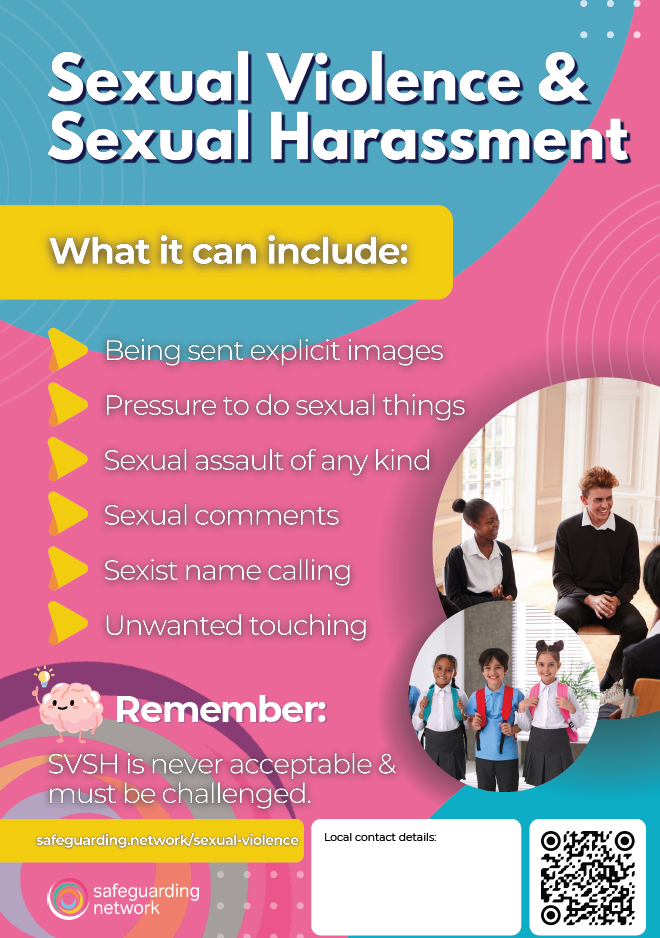Introduction
Sexual violence and sexual harassment can occur between children of any age or gender, and between individuals or groups. They exist on broad scale and may overlap, occurring online and face to-face (both physically and verbally), and both in and outside education settings.
The impact of child sexual violence and sexual harassment can be devastating, leading to long-term psychological and emotional trauma for the victims. Many children feel ashamed, scared and confused, and may struggle with feelings of guilt and self-blame. This can have a profound impact on their mental health, relationships and overall wellbeing.
Need more?
Thank you for visiting our resources pages. These are free to everyone as is our fortnightly safeguarding bulletin – general safeguarding information is too important to restrict. Become a member to access lots more, including training materials for you to deliver in-house on each topic in Keeping Children Safe in Education.
Sign up for FREE fortnightly bulletin.
What about training?
We can deliver training for your setting on this and other subjects via online platforms, or face-to-face in certain areas. Just get in touch to discuss your requirements.
All children and young people have a right to grow up safe from abuse and harassment. Settings working with children and young people are central to framing a safeguarding ethos and creating protected spaces for children and young people to explore healthy relationships.
Safeguarding professionals can protect children and young people from harm by changing expectations, challenging unacceptable behaviour and improving children and young people’s knowledge and understanding of healthy relationships.
Definitions
Sexual violence is rape, assault by penetration, sexual assault or causing someone to engage in sexual activity without consent.
Sexual harassment is unwanted conduct of a sexual nature.
Harmful sexual behaviour is problematic, abusive and violent behaviour by a child or young person that is developmentally inappropriate and may cause developmental damage.
Adapted from Keeping Children Safe in Education
Expanding the definitions
Whilst the definitions above are short and to the point, what do they mean?
Adapted from Keeping Children Safe in Education
Sexual violence –
- Rape is intentional penetration by the perpetrator with their penis without consent, and there is no reasonable belief that the victim consents.
- Assault by penetration is intentional sexual penetration by the perpetrator with a part of their body or anything else without consent, and there is no reasonable belief that the victim consents.
- Sexual assault is intentional sexual touching of the victim by the perpetrator without consent, and there is no reasonable belief that the victim consents. (Sexual assault covers a wide range of behaviour. A single act of kissing someone without consent or touching someone’s bottom/breasts/genitalia without consent, is still sexual assault.)
- Intentionally causing someone to engage in sexual activity without their consent, and there is no reasonable belief that they consent, is also an offence. This could include forcing someone to strip, touch themselves sexually, or to engage in sexual activity with a third party.
What is consent?
Consent is about having the freedom and capacity to choose (saying yes when being pressured, coerced, or threatened is not consent). Consent to sexual activity may be given to one sort of sexual activity but not another, e.g., to vaginal but not anal sex, or penetration with conditions, such as wearing a condom. Consent can be withdrawn at any time during sexual activity and each time activity occurs.
- A child under the age of 13 can never consent to any sexual activity.
- The age of consent is 16.
- Sexual intercourse without consent is rape.
Sexual harassment – ‘Unwanted conduct of a sexual nature’ that can occur between children and young people, online or offline, and both inside and outside of an education setting. It includes:
- sexual comments, such as telling sexual stories, making lewd comments, making sexual remarks about clothes and appearance, and calling someone sexualised names
- sexual “jokes” or taunting
- physical behaviour, such as, deliberately brushing against someone, interfering with someone’s clothes (settings should consider when any of this crosses a line into sexual violence – it is important to talk to and consider the experience of the victim) and displaying pictures, photos or drawings of a sexual nature
- online sexual harassment - including non-consensual sharing of nude and semi-nude images or videos, sharing of unwanted explicit content, upskirting, sexualised online bullying, unwanted sexual comments or messages (including on social media), sexual exploitation, coercion and threats.
Unchallenged sexual harassment creates a culture that can normalise inappropriate behaviours and provide an environment that may lead to sexual violence.
Harmful sexual behaviour – Children and young people’s sexual behaviour exists on a wide continuum. Problematic, abusive and violent sexual behaviour is developmentally inappropriate and may cause developmental damage. A useful umbrella term for this is “harmful sexual behaviour”. The term has been widely adopted in child protection.
Harmful sexual behaviour (HSB) can occur online and/or offline and can also occur simultaneously between the two. HSB should be considered in a child protection context and consider the ages and stages of development of the children and young people involved.
Children and young people displaying HSB have often experienced their own abuse and trauma. It's important they are offered appropriate support.
My boyfriend is sometimes violent towards me and recently he’s forced me into doing sexual things when I didn’t want to. It wasn’t always this way but it’s been going on for a few weeks now and I’m worried it’s going to get worse. I’m scared of how he would react if I tried to end the relationship. I don’t feel like I can speak to someone without my parents or friends at school finding out. I’m really scared.
Prevalence
According to the NSPCC, 87,000 sexual offences against children were recorded by police in 2022/23 and included rape, sexual assault, grooming and sexual exploitation.
The Girl’s Attitudes Survey by Girlguiding revealed 59% of 13-21-year-olds have seen or experienced sexual harassment.
In Ofsted’s Review of sexual abuse in schools and colleges (2021), children and young people reported the following things happened “a lot or sometimes” to them or their peers:
- unwanted touching
- pressure to do sexual things they didn’t want to
- sexual assault of any kind
- unwanted or inappropriate sexual comments
- sexist name calling
- being sent explicit pictures or videos of things they did not want to see.
The frequency of these harmful sexual behaviours means that some children and young people consider them normal.
Children and young people also told Ofsted that sharing nudes was widespread, along with “body shaming” and “slut shaming”, and they felt that teachers were out of touch with the realities of their pupils’ lives and what they had to endure, both in school and out of school, in terms of sexual harassment and sexual violence.
I was 13 the first time I was catcalled. I hated my body and felt guilt and shame for years.
Additional vulnerabilities
Anyone can experience sexual harassment and violence, but some children and young people are more vulnerable, including:
- Girls - records show girls are disproportionately affected. How Safe are Our Children? found 90% of recorded offences of rape in 13 to 15-year-olds were committed against girls.
- Children and young people who are, or are perceived to be, lesbian, gay, bi-sexual or transgender (LGBT).
- Children and young people with Special Educational Needs and Disabilities (SEND).
Spot the signs
Sometimes children and young people, or their friends, report sexual violence or harassment. At other times staff may observe something of concern and intervene.
Often, children and young people don't share their experiences. Staff should be aware of the possible signs and talk to their safeguarding lead about how to begin a conversation.
Children and young people may feel angry, upset, stressed, worried, scared and confused, and might:
- experience flashbacks
- have difficulty sleeping and night terrors
- have anxiety
- find it difficult to concentrate
- block out the memory and/or avoid remembering what happened
- be unable to remember exactly what happened
- find it difficult to trust people
- think that no one else understands them
- relive the experience of sexual abuse.
Some children and young people may not perceive they are being abused or harassed and need support, through sex and relationships education, to understand their experiences. However, sometimes lessons about sex, relationships and consent, could bring back bad memories that are difficult to deal with.
The Ofsted review of sexual abuse in schools and colleges recommends that schools, colleges and multi-agency partners act as though sexual harassment and online sexual abuse are happening, even when there are no specific reports. It found, concerningly, that for some children and young people, incidents are so commonplace that they see no point in reporting them.
The Our Streets Now Survey found 76% of pupils don’t feel confident reporting incidents of public sexual harassment to staff, and 72% of the pupils who did report said they received a negative response.
It’s not what actually happens that has the worst effect on you, it’s what comes after it. It’s the being disbelieved – it’s the people failing you.
What to do
It’s crucial that children and young people get the right response immediately from the adults they approach.
- Concerns, whether observed or disclosed, should be taken seriously and reported to the designated safeguarding lead without delay.
- Be aware of additional vulnerabilities – are there children at your setting who may be particularly vulnerable to sexual violence and/or sexual harassment? Could they benefit from early intervention?
- Consider the child’s lived experiences. Build and use your relationships with children and young people to understand what’s happening in their community (in school, locally and online). Be aware of the strong influence of peers and social media.
- Listen to/observe the ‘voice’ of the child. Children and young people often find it difficult to speak about their experiences – what is their behaviour trying to tell you? Work with them to build trust and be a safe person for them to come to when needed.
- Don’t assume the concern has already been reported by someone else.
- Take immediate action to keep children and young people safe.
- Provide reassurance and support to everyone involved. It’s essential that all victims are reassured that they are being taken seriously, regardless of how long it has taken them to come forward. They should never be made to feel ashamed for making a report or have their experience minimised.
- Don’t promise confidentiality, but do explain that only people who need to know will be told.
- Listen carefully, reflect back, be non-judgemental and don’t ask leading questions. Guidance recommends having two people present if possible.
- Write up a thorough factual summary after the child or young person has finished, using their own words as much as possible.
- If there is an online element (such as pictures or videos), do not view or forward this – you may refer to DfE advice on searching, screening and confiscation, and UKCIS Sharing nudes and semi-nudes: advice for education settings working with children and young people guidance.
Follow part five of Keeping Children Safe in Education and consider the most proportionate response, in consultation with the child or young person who experienced the abuse, and their parents or carers.
The response must include a risk assessment around the potential for reoccurrence, taking particular care to ensure the child or young person is safe from further abuse or reprisals, that other children or young people are protected, and that the alleged harmful child is receiving appropriate support. Action in some circumstances must involve children’s social care and/or the police.
Promote safeguarding
Settings should have in place an effective policy framework including clear communication routes for safeguarding concerns, a clear and understood behaviour policy, and a core set of underpinning standards and values that equip children and young people for positive relationships and adult life.
Staff should assert these values, with structural support from the safeguarding and pastoral teams and a supportive curriculum that addresses the potential for sexual violence and sexual harassment directly.
Contextual approach
A setting’s approach to sexual violence and sexual harassment should reflect and be part of the broader approach to safeguarding, transparent, and clear and easy to understand for staff, pupils, students, parents and carers.
All staff in the setting should be aware of, and consider, extra-familial harms around the local community, groups and gangs of children and young people, criminal/sexual exploitation, each child and young person’s family environment, and online activity/risks in devising an effective strategy to minimise the risk of sexual violence and harassment.
As one girl put it to the Ofsted review team: ‘It shouldn’t be our responsibility to educate boys’.
Staff training
It’s crucial staff are aware of behaviour that constitutes sexual violence or harassment and do not minimise or dismiss concerns. All staff should be aware of how to support children and young people and how to manage a safeguarding report from a child or young person.
Ofsted’s review of sexual abuse in schools and colleges revealed that many settings underestimated the scale of sexual harassment and online sexual abuse.
Some settings dealt with incidents in an isolated way, without considering the context and wider safeguarding risks, such as risks to other children and young people, unsafe spaces within the setting, peer power dynamics and unhealthy peer cultures.
Children and young people reported feeling disillusioned, embarrassed and left at risk of significant harm because of failures in their settings.
Ensure staff receive training on what to look for and practise how to respond. Such training should focus on improving outcomes for children and young people, be underpinned by robust evidence and expertise, include collaboration and expert challenge, and be sustained over time. Scenario work is effective in helping staff embed their learning.
Education of children and young people
Intervening early to ensure children and young people understand the boundaries of healthy relationships is key to preventative work.
Settings should have a planned programme of evidence-based content, delivered through the whole curriculum. The programme should build upon the setting’s clear set of values and standards, which are upheld and demonstrated throughout all aspects of student life and are underpinned by the setting’s behaviour policy and pastoral support system.
The content should be age and stage of development appropriate (especially when considering children and young people with SEND and their cognitive understanding), and may tackle such issues as:
- healthy and respectful relationships
- what respectful behaviour looks like
- consent
- gender roles, stereotyping and equality
- body confidence and self-esteem
- prejudiced behaviour
- understanding that sexual violence and sexual harassment is always wrong
- addressing cultures of sexual harassment
- addressing misogyny.
Good practice allows children and young people an open forum to talk things through and ensures that children and young people are made aware of how to raise concerns (including about friends/peers), make a report and how reports are handled.
Support for children and young people
It's essential that all victims are reassured that they are being taken seriously and that they will be supported and kept safe.
A victim should never be given the impression that they are creating a problem by reporting sexual violence or sexual harassment. A victim should never be made to feel ashamed for making a report.
Depending on the level of concern raised, and the needs of the children and young people involved, support may include that from the setting’s pastoral support team, early help services or more specialist support, such as counselling.
Whatever the setting’s response, it should be underpinned by the principle that sexual violence and sexual harassment is never acceptable, will not be tolerated and that all the children and young people involved (including the instigators of harm) will need support.
Settings should have access to specialist support about harmful sexual behaviour to contribute to their training, and to help them support children and young people where appropriate. There should also be access to specialist counselling or support for children and young people involved in concerning incidents.
Free sexual violence and sexual harassment poster
This downloadable resource raises the profile of safeguarding for your staff team. For use in staff rooms, on safeguarding boards or on the back of toilet doors the poster includes tips, a space for local contact details together with a link and QR Codes to this resource page. Download the poster from the resources below.
DSL Training Materials
-

SVSH Presentation
-

SVSH Presenter Notes
-

Handout for staff - SVSH
-

Sexual violence and sexual harassment – Quiz
-

Sexual violence and sexual harassment – Quiz (Answer Sheet)
-

Presentation – Sharing of Nudes and Semi-nudes
-

Presenter notes – Sharing of nudes and semi-nudes
-

Sexual violence and sexual harassment scenario (EYFS)
-

Sexual violence and sexual harassment scenario (EYFS) – DSL Information sheet
-

Sexual violence and sexual harassment scenario (Primary)
-

Sexual violence and sexual harassment scenario (Primary) – DSL Information sheet
-

Sexual violence and sexual harassment scenario (Secondary)
-

Sexual violence and sexual harassment scenario (Secondary) – DSL Information sheet
-

Sexual violence and sexual harassment scenario – 16+ / FE settings
-

Sexual violence and sexual harassment scenario – 16+ / FE settings – DSL Information Sheet
-

Sexual violence and sexual harassment scenario (SEND)
-

Sexual violence and sexual harassment scenario (SEND) – DSL Information sheet
-

Sexual violence and sexual harassment scenario (Care)
-

Sexual violence and sexual harassment scenario (Care) – DSL Information sheet
Resources
-

Sexual violence and sexual harassment poster
-

Help for schools
-

Children and young people who display harmful sexual behaviour
-

Anti-social media
-

Addressing School Avoidance
-

Harmful sexual behaviour - guidance and resources for education professionals
-

Childline – Healthy and unhealthy relationships
-

Review of sexual abuse in schools and colleges
-

Advice regarding the sharing of nude and semi-nude images
-

Take It down
-

Childline – Report Remove tool
-

Enough – Teaching Resources
-

Our Streets Now
-

Preventing Harmful Sexual Behaviour
-

Childnet – campaign toolkit
-

A safe space for young people worried about sexual behaviour
-

Sexual abuse learning programme
-

Sexual Violence and Sexual Harassment Audit Tool
-

Consent is Everything
Save time and improve your safeguarding approach…
Bite-size training materials to share with your staff every month.
Support to explore and develop your safeguarding culture.
A huge array of resources and professional experience at your fingertips.
Get in touch now for a personal tour of the site and details of membership benefits.
We look forward to working with you.


